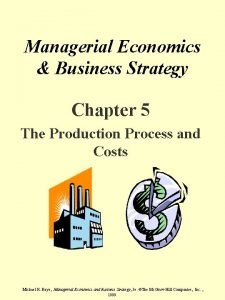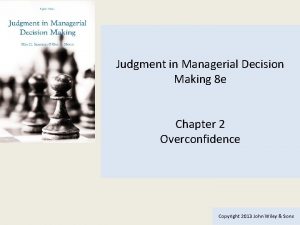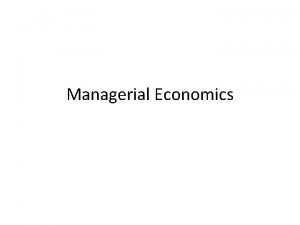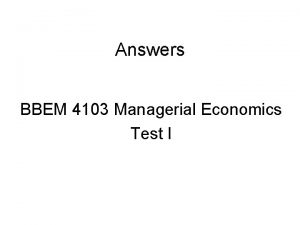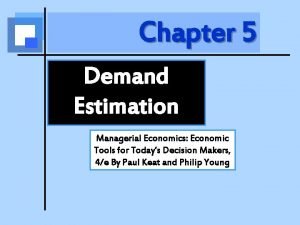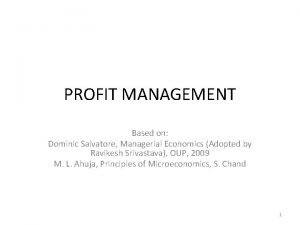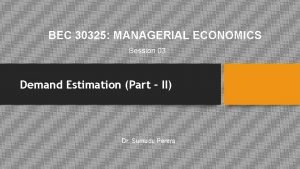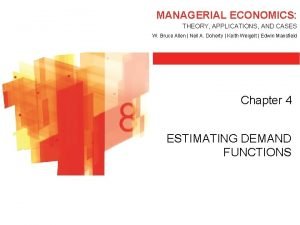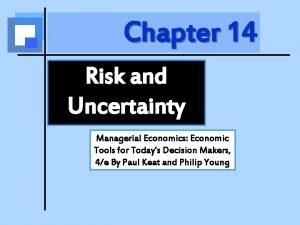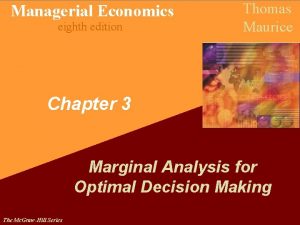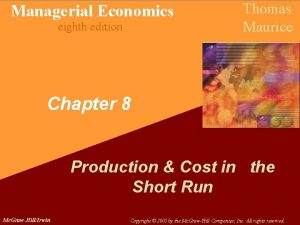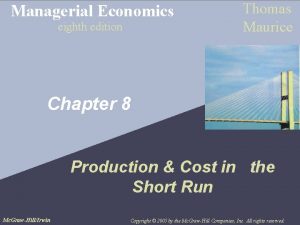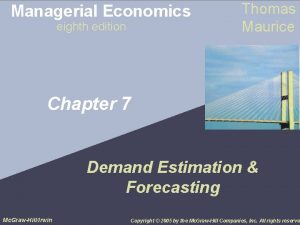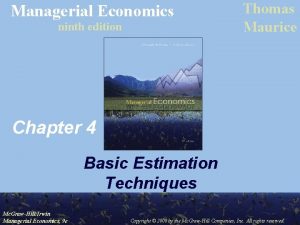Managerial Economics eighth edition Thomas Maurice Chapter 6





























- Slides: 29

Managerial Economics eighth edition Thomas Maurice Chapter 6 Elasticity and Demand Mc. Graw-Hill/Irwin Copyright © 2005 by the Mc. Graw-Hill Companies, Inc. All rights reserved.

Managerial Economics 2 Price Elasticity of Demand (E) • • • P & Q are inversely related by the law of demand so E is always negative • The larger the absolute value of E, the more sensitive buyers are to a change in price 2 Mc. Graw-Hill/Irwin Copyright © 2005 by the Mc. Graw-Hill Companies, Inc. All rights reserved.

3 Managerial Economics Price Elasticity of Demand (E) Table 6. 1 Elasticity Responsiveness E Elastic Unitary Elastic Inelastic 3 Mc. Graw-Hill/Irwin Copyright © 2005 by the Mc. Graw-Hill Companies, Inc. All rights reserved.

4 Managerial Economics Price Elasticity of Demand (E) • Percentage change in quantity demanded can be predicted for a given percentage change in price as: • % Qd = % P x E • Percentage change in price required for a given change in quantity demanded can be predicted as: • % P = % Qd ÷ E 4 Mc. Graw-Hill/Irwin Copyright © 2005 by the Mc. Graw-Hill Companies, Inc. All rights reserved.

5 Managerial Economics Price Elasticity & Total Revenue Table 6. 2 5 Elastic Unitary elastic Inelastic Q-effect dominates No dominant effect P-effect dominates Price rises TR falls No change in TR TR rises Price falls TR rises No change in TR TR falls Mc. Graw-Hill/Irwin Copyright © 2005 by the Mc. Graw-Hill Companies, Inc. All rights reserved.

6 Managerial Economics Factors Affecting Price Elasticity of Demand • Availability of substitutes • The better & more numerous the substitutes for a good, the more elastic is demand • Percentage of consumer’s budget • The greater the percentage of the consumer’s budget spent on the good, the more elastic is demand • Time period of adjustment • The longer the time period consumers have to adjust to price changes, the more elastic is demand 6 Mc. Graw-Hill/Irwin Copyright © 2005 by the Mc. Graw-Hill Companies, Inc. All rights reserved.

7 Managerial Economics Calculating Price Elasticity of Demand - Tues • Price elasticity can be calculated by multiplying the slope of demand ( Q/ P) times the ratio of price to quantity (P/Q) 7 Mc. Graw-Hill/Irwin Copyright © 2005 by the Mc. Graw-Hill Companies, Inc. All rights reserved.

8 Managerial Economics Calculating Price Elasticity of Demand • Price elasticity can be measured at an interval (or arc) along demand, or at a specific point on the demand curve • If the price change is relatively small, a point calculation is suitable • If the price change spans a sizable arc along the demand curve, the interval calculation provides a better measure 8 Mc. Graw-Hill/Irwin Copyright © 2005 by the Mc. Graw-Hill Companies, Inc. All rights reserved.

9 Managerial Economics Computation of Elasticity Over an Interval • When calculating price elasticity of demand over an interval of demand, use the interval or arc elasticity formula 9 Mc. Graw-Hill/Irwin Copyright © 2005 by the Mc. Graw-Hill Companies, Inc. All rights reserved.

10 Managerial Economics Let’s Try an Interval E • Say Price drops from $18 to $16 • This causes a increase in quantity demanded of 200 • What is the price elasticity of demand over this interval? 10 Mc. Graw-Hill/Irwin Copyright © 2005 by the Mc. Graw-Hill Companies, Inc. All rights reserved.

11 Managerial Economics Computation of Elasticity at a Point • When calculating price elasticity at a point on demand, multiply the slope of demand ( Q/ P), computed at the point of measure, times the ratio P/Q, using the values of P and Q at the point of measure • Method of measuring point elasticity depends on whether demand is linear or curvilinear 11 Mc. Graw-Hill/Irwin Copyright © 2005 by the Mc. Graw-Hill Companies, Inc. All rights reserved.

Managerial Economics 12 Point Elasticity When Demand is Linear 12 Mc. Graw-Hill/Irwin Copyright © 2005 by the Mc. Graw-Hill Companies, Inc. All rights reserved.

13 Managerial Economics Point Elasticity When Demand is Linear • Compute elasticity using either of the two formulas below which give the same value for E 13 Mc. Graw-Hill/Irwin Copyright © 2005 by the Mc. Graw-Hill Companies, Inc. All rights reserved.

14 Managerial Economics Point Elasticity When Demand is Curvilinear • Compute elasticity using either of two equivalent formulas below 14 Mc. Graw-Hill/Irwin Copyright © 2005 by the Mc. Graw-Hill Companies, Inc. All rights reserved.

15 Managerial Economics Let’s try a point E • If we want to calculate a point elasticity at the point where price = $5 and quantity = 90 • The line equation y = 100 – 2 p or Q = 100 – 2 p • We can use 15 Mc. Graw-Hill/Irwin Copyright © 2005 by the Mc. Graw-Hill Companies, Inc. All rights reserved.

16 Managerial Economics Elasticity (Generally) Varies Along a Demand Curve • For linear demand, price and E vary directly • The higher the price, the more elastic is demand • The lower the price, the less elastic is demand • For curvilinear demand, no general rule about the relation between price and quantity 16 Mc. Graw-Hill/Irwin Copyright © 2005 by the Mc. Graw-Hill Companies, Inc. All rights reserved.

17 Managerial Economics Constant Elasticity of Demand (Figure 6. 3) 17 Mc. Graw-Hill/Irwin Copyright © 2005 by the Mc. Graw-Hill Companies, Inc. All rights reserved.

18 Managerial Economics Computation of Elasticity Over an Interval • Marginal revenue (MR) is the change in total revenue per unit change in output • Since MR measures the rate of change in total revenue as quantity changes, MR is the slope of the total revenue (TR) curve 18 Mc. Graw-Hill/Irwin Copyright © 2005 by the Mc. Graw-Hill Companies, Inc. All rights reserved.

19 Managerial Economics Demand & Marginal Revenue (Table 6. 3) 19 TR = P Q MR = TR/ Q Unit sales (Q) Price 0 $4. 50 1 4. 00 $4. 00 2 3. 50 $7. 00 $3. 00 3 3. 10 $9. 30 $2. 30 4 2. 80 $11. 20 $1. 90 5 2. 40 $12. 00 $0. 80 6 2. 00 $12. 00 $0 7 1. 50 $10. 50 $-1. 50 Mc. Graw-Hill/Irwin $ 0 -- Copyright © 2005 by the Mc. Graw-Hill Companies, Inc. All rights reserved.

20 Managerial Economics Demand, MR, & TR Panel A 20 Mc. Graw-Hill/Irwin (Figure 6. 4) Panel B Copyright © 2005 by the Mc. Graw-Hill Companies, Inc. All rights reserved.

21 Managerial Economics Demand & Marginal Revenue • When inverse demand is linear, = A + BQ P • Marginal revenue is also linear, intersects the vertical (price) axis at the same point as demand, & is twice as steep as demand MR = A + 2 BQ 21 Mc. Graw-Hill/Irwin Copyright © 2005 by the Mc. Graw-Hill Companies, Inc. All rights reserved.

22 Managerial Economics Linear Demand, MR, & Elasticity (Figure 6. 5) 22 Mc. Graw-Hill/Irwin Copyright © 2005 by the Mc. Graw-Hill Companies, Inc. All rights reserved.

23 Managerial Economics MR, TR, & Price Elasticity Table 6. 4 Marginal Total revenue MR > 0 TR increases as Q increases MR = 0 TR is maximized MR < 0 23 Mc. Graw-Hill/Irwin Price elasticity of demand Elastic ( E > 1) 1) Unit elastic ( E = 1) 1) TR decreases as Inelastic Q increases ( E < 1) 1) Copyright © 2005 by the Mc. Graw-Hill Companies, Inc. All rights reserved.

24 Managerial Economics Marginal Revenue & Price Elasticity • For all demand & marginal revenue curves, the relation between marginal revenue, price, & elasticity can be expressed as 24 Mc. Graw-Hill/Irwin Copyright © 2005 by the Mc. Graw-Hill Companies, Inc. All rights reserved.

25 Managerial Economics Income Elasticity • Income elasticity (EM) measures the responsiveness of quantity demanded to changes in income, holding the price of the good & all other demand determinants constant • Positive for a normal good • Negative for an inferior good 25 Mc. Graw-Hill/Irwin Copyright © 2005 by the Mc. Graw-Hill Companies, Inc. All rights reserved.

26 Managerial Economics Cross-Price Elasticity • Cross-price elasticity (EXY) measures the responsiveness of quantity demanded of good X to changes in the price of related good Y, holding the price of good X & all other demand determinants for good X constant • Positive when the two goods are substitutes • Negative when the two goods are complements 26 Mc. Graw-Hill/Irwin Copyright © 2005 by the Mc. Graw-Hill Companies, Inc. All rights reserved.

27 Managerial Economics Interval Elasticity Measures • To calculate interval measures of income & cross-price elasticities, the following formulas can be employed 27 Mc. Graw-Hill/Irwin Copyright © 2005 by the Mc. Graw-Hill Companies, Inc. All rights reserved.

Managerial Economics 28 Point Elasticity Measures 28 Mc. Graw-Hill/Irwin Copyright © 2005 by the Mc. Graw-Hill Companies, Inc. All rights reserved.

29 Managerial Economics Homework • Read Chapter 6 • Do Technical Problems: 1, 2, 3, 4, 5, 7, 9, 10, 12, 13, 15, 16 • Do Applied Problems: 1, 3, 4, 6, 8, 29 Mc. Graw-Hill/Irwin Copyright © 2005 by the Mc. Graw-Hill Companies, Inc. All rights reserved.
 Managerial economics hirschey
Managerial economics hirschey Psychology eighth edition david g myers
Psychology eighth edition david g myers Psychology
Psychology Operations management eighth edition
Operations management eighth edition Managerial economics chapter 5
Managerial economics chapter 5 Fundamental economic concepts in managerial economics
Fundamental economic concepts in managerial economics Scope and nature of managerial economics
Scope and nature of managerial economics Judgement in managerial decision making
Judgement in managerial decision making Meaning of managerial economics in simple words
Meaning of managerial economics in simple words Two basic components of incremental reasoning are:
Two basic components of incremental reasoning are: Managerial economics
Managerial economics Demand estimation and forecasting
Demand estimation and forecasting Meaning of managerial economics
Meaning of managerial economics Cost estimation in managerial economics
Cost estimation in managerial economics Managerial economics test questions and answers
Managerial economics test questions and answers Transfer pricing in managerial economics
Transfer pricing in managerial economics Game theory managerial economics
Game theory managerial economics Equi marginal principle in managerial economics
Equi marginal principle in managerial economics Nature and scope of managerial economics
Nature and scope of managerial economics Engineering and managerial economics
Engineering and managerial economics What is demand estimation in managerial economics
What is demand estimation in managerial economics Pricing practices in managerial economics
Pricing practices in managerial economics Profit management in managerial economics
Profit management in managerial economics Example of managerial economics
Example of managerial economics Demand and supply in managerial economics
Demand and supply in managerial economics The goal of the firm should be
The goal of the firm should be Demand estimation in managerial economics
Demand estimation in managerial economics Managerial economics: theory, applications, and cases
Managerial economics: theory, applications, and cases Managerial economics applications strategy and tactics
Managerial economics applications strategy and tactics Risk and uncertainty in managerial economics
Risk and uncertainty in managerial economics




